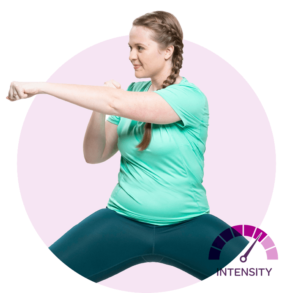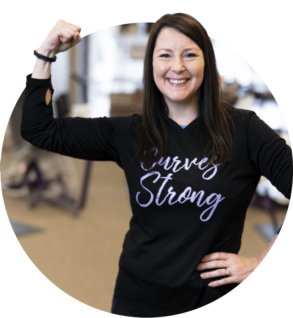Exercise to Extend your Life
You know exercise makes you feel great. You know it helps control your weight. And you know the whole body workout you do at Curves is good for your health. But did you also realize exercise can add years to your life? With all its benefits, a workout plan like the Curves Circuit can extend the quantity—and quality—of your life.
With that being said, considering all the exercise advice out there, it can be tough to know how long and how intensely to work out. The U.S Department of Health and Human Services’ recommendations1 for exercise say you should engage in 150 minutes of moderate exercise per week to be physically fit. This comes out to about 30 minutes a day, five days a week. But, is more exercise than that better when it comes to living longer, or can you actually wear your body out? Here’s some advice to help you understand the best way to exercise to lengthen your life with your workout plan.
The fitness formula for longevity
Two recent studies, both published in JAMA Internal Medicine, looked at the connection between exercise and longevity. They yielded some interesting findings.
A study2 at Harvard University, National Cancer Institute, and other institutions found:
– People who never exercised were at the highest risk of early death
– People who exercised less than recommended reduced the risk of early death by 20%
– People who met the exercise recommendations reduced the risk by 31%
– People who exercised triple of the recommendations (>1 hour/day) reduced the risk by 39%
A second study3 found the intensity of exercise matters:
– People who followed exercise guidelines at moderate pace were at reduced risk of early death
– People who followed the guidelines with additional vigorous activity reduced the risk further by 9% in comparison to moderate pace and 13% in comparison to people who never work out at all.
The moral: Try to meet at least the guidelines of 150 minutes of activity per week, 20 to 30 minutes of which is vigorous. At Curves, you can do this by adding intervals where you push yourself a little harder through your whole body workout routine or try a cardio or boxing class to mix things up.
The science behind a good sweat
So, now that you know some of the research behind exercise and longevity, let’s look at the reasons why full body workouts like the Curves Circuit add years to your life. Research has shown, the best way to live a longer, healthier life4 is to eat well, get enough sleep, exercise, and avoid bad habits like smoking or drinking too much alcohol. Among these activities, exercise is one of the most important. Here’s why:
It wards off disability
The more physically fit you are, the less likely you are to become injured or permanently disabled. In a study funded by the National Institutes of Health, researchers looked at more than 600 adults aged 70 to 89 who were at risk for disability. They then randomly placed the adults in a moderate exercise group that worked up to 150 minutes of weekly activity, or a group that included no exercise. The exercise group did a combination of brisk walking, balance training, flexibility exercises, and strength training. After two years, the exercise group had less disability, and those who did get injured were laid up for a shorter amount of time than those who failed to engage in any gym workout or exercise routine.
It helps keep you trim
Being overweight puts you at a higher risk for many diseases and conditions, from diabetes to cardiovascular disease to certain types of cancer. As a result, research5 shows having a high body mass index (BMI) shortens your lifespan. People with a BMI over 30 (the definition of obese) are at a particularly high risk of early death. In fact, a 2017 study published in Nature Communications6 found that for every one-unit increase in BMI, a person’s life expectancy dropped by seven months. Engaging in the Curves Circuit is a great way to spark weight loss after 40 and beyond.
It will serve you better if you’re trim
Research7 shows exercise benefits people of all shapes and sizes; but if you’re at a normal weight, it will do your body extra good. A study done by Brigham and Women’s Hospital and National Cancer Institute looked at data from more than 650,000 people over 10 years. The researchers found normal weight people who exercised the recommended amount—at least 75 minutes of brisk walking per week—added 7.2 years to their lives compared to people with BMIs of 35 or more who didn’t exercise. How’s that for added motivation to engage in a full body workout to drop those last few stubborn pounds?
It’s more fun next to friends
At Curves, we want you to share the love. We are all in this together, and we believe in giving each other the support we all deserve to start and continue the best workout of our lives. As a Curves member, you can help empower someone you care about to take control of her future and join you during your whole body workout. If we each bring one new person to try the Curves Circuit as part of a workout plan, together we will help change the lives of tens of thousands of women. In turn, these women can then become healthy role models and inspire many more people around them as well. So, make it your mission to partner with Curves over the next 30 days to help someone you know and love to live a healthier, stronger, LONGER life.
†The information contained above is presented in summary form only and intended to provide broad consumer understanding and knowledge of various healthcare topics. It should not be used in place of a visit, call, consultation or advice of your doctor or other healthcare provider. You should discuss any dietary changes or supplement usage with your doctor, and should not discontinue any prescription medications without first consulting your doctor.
Curves offers a variety of exercise classes for women — high-intensity women’s boxing classes and cardio classes, medium to low-intensity women’s fitness classes, and low-intensity women’s balance classes. Each class is designed to to give you an effective total body workout in just 30 minutes!
To find out more about how you can informed lifestyle and health choices, visit our blog under the ‘Live‘ category! You can also learn more about how the ‘Curves Circuit‘ can benefit your lifestyle here.
Sources








